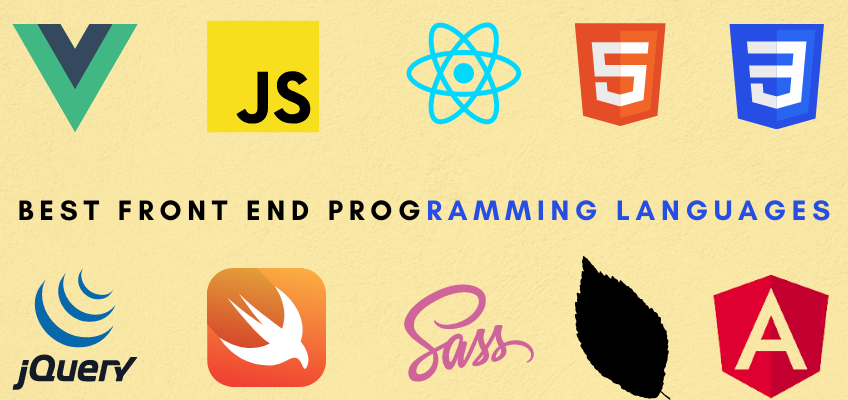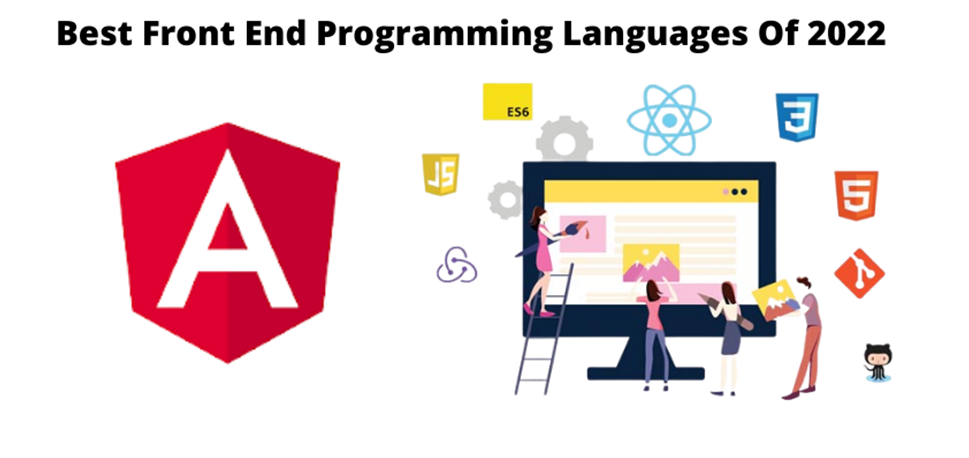This article will discuss the best ten front-end programming languages, their advantages, core features, and limitations. The list includes Javascript, CSS, HTML, React, Angular, Vue, Swift, Elm, SASS, and jQuery. In developing a web or mobile application, the front-end or client-side is essential as a user only experiences it. Although the backend also matters a lot, the user can only witness what is happening on the front end. Thus, to improve the impression of your application before the user, a developer can not compromise on the quality of the front-end development.
Front-end languages play a significant role in providing a great client-side user experience. That is why this blog is going to share the best front-end languages with their features. HTML is the simplest front-end language to add to a developer’s skillset. But, if you are a beginner, a developer, or a business, you must see these top ten front-end languages with their features. Keep reading to know more.

1. React
React is a front-end programming language that works within JS to enhance usability features. It is an open-source library that was released in 2012. It was developed by Facebook about ten years ago and is now used for major web applications such as Instagram, WhatsApp, Facebook, Yahoo! Etc. React became popular due to the wide variety of tools available to improve user experience. Over 1,383,673 websites across the globe are currently using React. JS. The USA is among the leading countries using it as a front-end language. React is an excellent choice for front-end and full-stack development.
Core Features
- Easy Debugging-It means that as a framework or a library, it should have the proper tools to work effectively and efficiently. One of the primary features of React is easy debugging. Its simplicity doesn’t leave much room for error, and debugging can be done before the code is executed.
- Readily Accepts JSX-React has many built-in features that offer a basis for what to accept as text. It readily accepts JSX and supports HTML quoting as well. It can assist in easy learning for a new developer.
- SEO Support-React is SEO friendly and can easily show up at a heavy load. SEO support gives it a significant advantage for high-load applications in terms of SEO.
2. JavaScript
JavaScript has been in the digital market for a much extended period. It is one of the most commonly used mechanisms for front-end development alongside CSS and HTML. It is a simple language and is easy to understand, learn and implement. A lot of other backend languages support JavaScript. It first appeared in 1996 and has improved a lot. Nearly 97.5 % of web applications use JavaScript as a front-end language. Indeed, known applications such as Uber and Netflix employ JavaScript as well. Examples of Javascript libraries are Angular, jQuery, React, and Parsley.
Core Features
- Feature-Rich Design-It could create pretty intriguing and attractive interfaces.
- Client-Side Architecture- It uses a “client-side” model. It means that JavaScript reduces the load on the server and is quite fast as per the client’s resources.
- Supports a wide array of Languages-JavaScript has support for HTML and can easily be cascaded through that to manage content.
- Security Checks-It requires proper security checks and encryption within the code as the “Client-side” architecture.
3. CSS Cascading
Style Sheets is one of the best front-end languages. CSS is a web design tool often used to manage the layout of a webpage. CSS is a separate cascading style. It works in the front end. It is basically a small file that copulates the back end with a small file. Moreover, it ensures that the front-end language understands the code and how it works. It first came out in 1997, a year after JavaScript. The W3C developed it.
Core Features
- Lesser load on the HTML File-It could be used with HTML code to cascade the HTML file and its contents to allow for a lesser load on the HTML code.
- Cascading Style Framework-It can be advantageous to the various web pages with many different kinds of content or container load.
- Functionally Rich-CSS has a lot of functions in terms of text styling, fonts, and colors. It can control the feel and look of your entire web page with simple font color and size.
- Cross-Browser Support-It ensures cross-browser support and the browser understands the placement and efficient running of the code.
- Endorses Uniformity Through Platforms-CSS ensures that the content and data are in the correct syntax. Thus, there is less room for error left in the content and readability.
4. HTML
HTML or hypertext markup language is usually used to develop web pages, websites, and apps. After its initial release in 1994, it has been constantly updated to add new features. The latest release of HTML 5 just occurred recently. Novice developers prefer to begin their front-end programming career with HTML.
Core Features
- Easy to Learn and Implement-It is a free and simple-to-understand language. It is not difficult to use this language with any given implementation. It is also directly understood by any browser without masking it with any other front-end language.
- Widely Understood-It is still preferred as an alternative program for developing a backend code. It is because it is small, uncomplicated, and widely understood.
- Easy Testing & Debugging-HTML is user-friendly and easily understandable by the user, even if an error is made in the layout or formatting. HTML is also among the most lightweight front-end languages available right now.
- Seamless Integration with other Languages-HTML is effortless to edit alongside any other code. HTML can be integrated early with any other form of code. Many programmers that have knowledge of any backend or front-end language have used HTML.
5. Angular
It is a modern front-end development tool that is becoming popular with many applications with the “feed” layout. Angular is getting increasingly popular after its initial release in 2015, and it is an excellent choice for web development. Big names such as Autodesk and Microsoft are currently using this technology. Angular can help you create dynamic single-page ( SPAS ) and interactive web applications with the help of its unique features.
Core Features
- Restful API-Designers can use HTML as a template language. They can extend the HTML syntax to supply the software components. Angular does not need the designer to rely on third-party libraries to create web applications using Angular.
- Separation of Concerns & Dependency Injection-Angular divides the load on both the client and the server to ensure that all components are spontaneously loaded.
- AJAX Handling-Angular allows for an easy and effective means to employ and handle AJAX concerns.
- Easy Testing and Debugging-Angular has features that allow easy testing, as the code can be run at any point to test functionalities.
6. Vue
Vue is among the top dynamic front-end languages for creating a specific interface. Vue was initially released in 2014, Vor active data binding. In addition, this framework can be operated on an electron builder. It can also provide support for both mobile and desktop applications. Vue takes its inspiration from React and Angular, both well-established in the market. It can support and permit a more simple understanding for new developers looking to implement this technology.
Core Features
- Ideal for Single-Page Designs- It is the perfect food for complicated single-page applications combined with support libraries and modern tools. Vue has easy integration with the backend code since it does not need much change in existing applications.
- Front End Integration-The core library considers the user’s ease of the presentation layer to make it easy. It also integrates with other existing projects or libraries.
- Numerous Plugins Available-It can be built on JavaScript applications as well.
7. jQuery
jQuery is a small library that is embedded in a JavaScript file. It changes the behavior of JavaScript and its functionality. Indeed, this tool can be used for end-to-end programming projects.
Core Features
- DOM Support- It allows much manipulation in Document Object Models ( i.e., DOM ). Animation Support jQuery offers excellent support for animations like the carousel and fade-in. It is simple to understand since it is based directly on JavaScript.
- Special Text Effects-jQuery enables users to add special effects to a simple JavaScript file. Moreover, it is advantageous to anyone wanting to make the program attractive.
- Well-Documented-It has a wide variety of support available. It makes it easy for anyone getting into it to understand the implementation. It also has API support. Thus, if you run into an error, you can find solutions.
- Universal Browser Support-jQuery includes support over various browsers. It can also be run on older systems.
- AJAX Support-It can also support Ajax functions. Thus, you can make constantly updated web pages.
8. Swift
Swift is another valuable and pure front-end language. Swift was developed by Apple Inc. in 2015. Since then, it has become increasingly popular. It has recently gotten Windows support since its September 2019 release.
Core Features
- Easy to Learn-Swift is simple to write and read. In this regard, coders must be grateful for its simplified grammar, spelling, and syntax. Even a novice could write the perfect code.
- Ideal for Apple Software-Its current performance is pretty impressive. It can be a perfect option for macOS, iOS, watchOS, and tvOS devices.
- Support Network-You will easily find the Swift development of the project as per your needs.
- Immediate Shifting to Swift The adaptation process is quicker with a simple and short codebase. Coding in Swift is simple for a beginner to read since it is primarily in English and straightforward.
- Error Management-Swift has an efficient error-handling capability, strong typing, and security features. In this way, the probability of code crashing and error reduces. It can quickly identify bugs. It can fix them. It is efficient and easier to integrate.
9. SASS
Syntactically Awesome Stylesheets, or SASS, is a CSS preprocessor. It first came out in 2007 to simplify CSS and maximize its capabilities.
Core Features
- Uses Windows Functions- extends the standard Windows functions that represent the main benefits of the programming language.
- Customizability Features allow you to use mathematical operations, variables, import functionality, mixins, loops, and other cool features that make the CSS much more powerful.
- Offers Variables- It offers Variables. It is a massive advantage over CSS; which becomes harder to carry forward data. Variables make it simpler to understand values and data over a longer part of code.
10. Elm
It is a beginner-friendly program that provides a helpful package for anyone getting into front-end languages. Elm has a few restrictions in terms of the ways you code.
Core Features
- Scalable-Elm language is scalable and less error-prone. It has a helpful compiler that ensures your code is readable and easy to maintain.
- Front End and Back End Support?—?It was initially made to be a simple front-end language. However, the server side is also easily programmable in this language. It makes it easy for an expert not to depend upon any external language for code.
Conclusion
This blog presented the 10 best front-end programming languages. Whether you are a business or a coder, it is crucial to understand the programming needs of your web application. After understanding your software’s needs, it will be convenient to pick the correct front-end programming language to make your venture successful.

Comment
Write a Reply or Comment